COPYRIGHT, PLEASE NOTE
All the material on this website is copyrighted to J-P Metsavainio, if not otherwise stated. Any content on this website may not be reproduced without the author’s permission.
BUY A MUSEUM QUALITY POSTER
BUY A POSTER:https://astroanarchy.zenfolio.com/
Sunday, October 5, 2008
O-III Veil in 3D-stereo pair images
Since weather do not give any support, I played with a data I have.
Vei Nebula is a supernova remaint. Leftovers from massive explosion
have spred around space. This presentation shows again the "real" nature of this object.
Image is a false color, Blue, since O-III is located on the Blue/Green part of the spectrum.
Viewing instructions can be found from the right hand side menu.

Cross Vision version
Labels:
stereo images
Thursday, October 2, 2008
Veil Nebula in O-III light
-

This is a start of the new project.
I will shoot The Veil Nebula in two color narrowband,
where O-III is Blue and H-alpha is Red, Green will be
synthesized from Red and Blue.
-
Not a very good star though, at fist night (29.09.) I was able to shot
only three 20min. frames. Thats a way too litle for O-III light.
I'll shoot more , if weather up here ever permits it,
two more hours is needed here, I think.
-
In the final image O-III will be precented as Blue color.
Tokina 300 AT-X @ f2.8, is a very good lens for this target,
the field of view is perfect march for the Veil.
_

Here is an image where stars are removed,
it's interesting to see how far the O-III area really goes.
-
For more information about this object, please, go here:
-
Imaging data:
-
Camera,
QHY8
-
Filters,
Baader 8,5nm O-III
-
Optics,
Tokina AT-X 300mm @ f2.8
-
Exposures,
3 X 1200 O-III
+ flats and bias
-
Guiding,
LX200 GPS 12" + PHD-guiding and Lodestar
Monday, September 29, 2008
Butterfly Nebula in narrowband colors
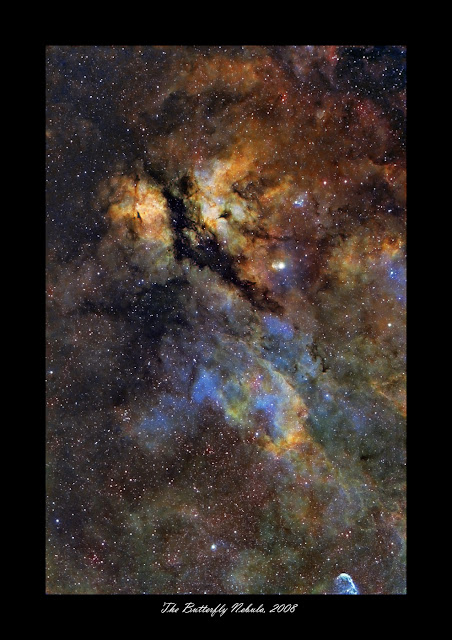G(H-a)B(O-III)+ISO.jpg)
At last I was able to shot S-II channel for this image!
Last night was stormy and since I don't have a proper observatory, wind made
imaging really difficult. About half of the frames was shot trough speeding clouds.
In this image colors are showing difference between Double ionized Sulfur (Red),
Hydrogen alpha (Green) and triple ionized Oxygen (Blue).
This palette is generally known as a Hubble palette by the palette used to processing images
from Space telescope Hubble. Compared to my previous images, more details can be seen here.
-
Imaging data:
Camera, QHY8
Filters, Baader 7nm H-alpha and Baader 8,5nm O-III
Optics, Tokina AT-X 300mm @ f2.8
Camera, QHY8
Filters, Baader 7nm H-alpha and Baader 8,5nm O-III
Optics, Tokina AT-X 300mm @ f2.8
Exposures, 5 X 1200s H-alpha 3 X 1200s O-III
4 X 1200s S-II + flats and bias
-Guiding, LX200 GPS 12" + PHD-guiding and Lodestar
-
-
Just noticed, that there is a cosmic Seagull in the image!
It just reising its wings.
Butterfly in Narrowband Stereo
G(H-a)B(O-III)+PARALLEL+VISION.jpg) Parallel Vision image pair
Parallel Vision image pair G(H-a)B(O-III)+CROSS+VISION.jpg) Cross Vision image pair -
Cross Vision image pair -
For viewing istructions, please, look at the menu on the right hand side of the page.
Labels:
stereo images
Sunday, September 28, 2008
Butterfly Nebula, Colors of Autumn

I made some tests about colorbalance. I looked more closely
O-III channel and compared it to the H-alpha channel.
There was some large scale differences between those two.
This experiment is done to make those differences more visible.
Green channel is synthesized from O-III and H-alpha channels.
I think, this color scheme is very suitable for season up here.
Butterfly Nebula in 3D-stereo pair
First image pair is for "Parallel Vision" method.
Second one is for "Cross Vision" method.
Viewing instructions can be found here:
http://astroanarchy.blogspot.com/search/label/Stereo%20image%20viewing%20instructions
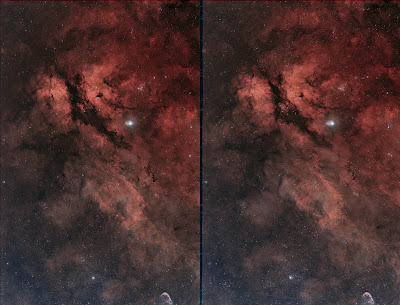
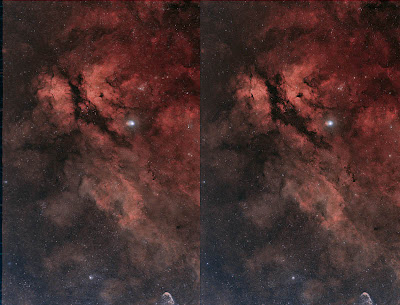
Labels:
stereo images
Saturday, September 27, 2008
Butterfly Nebula, second try
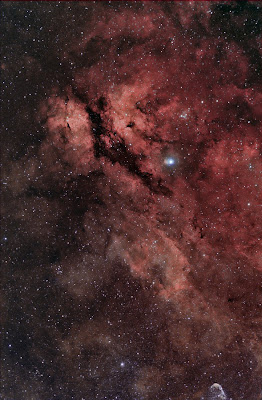
O-III = Blue. Green channel is Synthesized from Red and Blue.
-
Conditions were not too good last night, hard wind and clouds.
Guiding was really difficult doe the wind but PHD-guiding software does its best.
There was jus enough gaps between clouds, that I managed shot data for H-alpha
and O-III not enough though.
Actually part of the frames are shot trough not so thin clouds, maybe
H-alpha acts as a cloud filter : )
S-II data had to be left to the next time after the clouds rolled in.
Part of the NGC6888 the "Crescent Nebula" can be seen in the bottom of the image.
-
Imaging data:
-
Camera,
QHY8
-
Filters,
Baader 7nm H-alpha and Baader 8,5nm O-III
-
Optics,
Tokina AT-X 300mm @ f2.8
-
Exposures,
5 X 1200s H-alpha
3 X 1200 O-III
+ flats and bias
-
Guiding,
LX200 GPS 12" + PHD-guiding and Lodestar
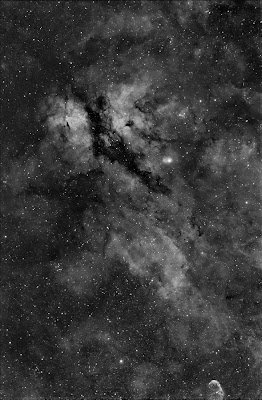
H-alpha channel
Wednesday, September 24, 2008
Butterfly Nebula from bad night
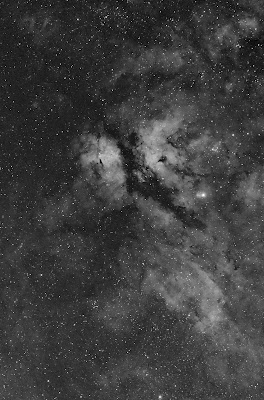
Sometimes there is days (nights), when everything goes wrong.
Last night was one of them.
First I had problems with my laptop and I had to reboot it several times.
It's a old well served Dell and booting it up takes for ever.
Then one of the cord to telescope was damaged and it took about an hour to
figure it out. After that I was ready so start my narrowband imaging session with
three filters.
First I selected H-alpha filter and got everything ready for imaging.
Guider was working fine and I started recording. I went out and stepped on the main power cord. Total blackout to the telescope. Huh... After an hour I got all on and running again (reinstalling couple of drivers etc...)
There was no more time for all three bands anymore, so H-alpha was now my goal.
After 7 x 1200s (20 min.) exposure they all looked good.
BUT BUT... when I examined them more closely and extracted red pixels from RAW-images
(thats how it works with one shot clor camera), I notised DEW, all but firs image was contaminated by dew.
There is a heater for my filter drawer to prevent dewing and cord from the power unit
was damaged! I soldered it back together but there was not enough night left for anything.
I shot flat frames just to be sure, and went to sleep for two hours before work.
Image here is a one twenty minutes exposure!
Camera, QHY8
Filter, Baader 7nm H-alpha
Optics, Tokina AT-X 300mm f2.8
Exposure, 1 X 1200s + flats and bias
Guiding, LX200 GPS 12" + PHD-guiding and Lodestar
Labels:
Tokina 300mm f2.8 images
Wednesday, September 17, 2008
NGC7000 as a Stereo Pair image
-
Images are stereo vision image pairs.
They tell something about "true" nature of this object.
This is not a accurate presentation of the real 3D dimensions,
but gives an idea about real nature of three dimensional object
floating in three dimensional space.
-
If you need istructions, please, look at the menu right side of the page.
Labels:
stereo images
Subscribe to:
Comments (Atom)













